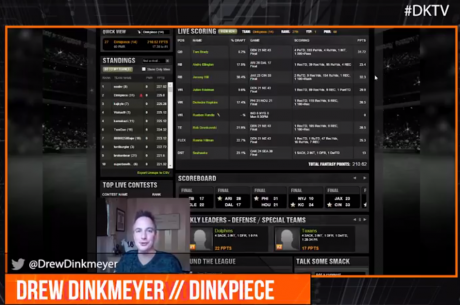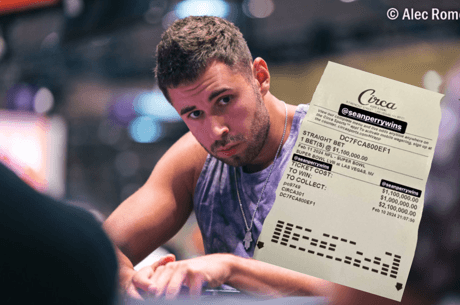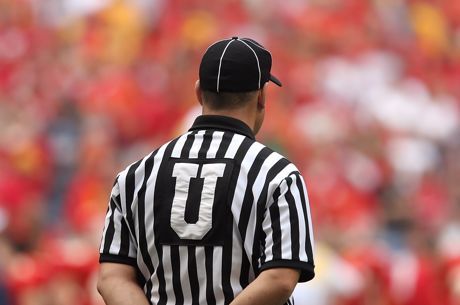Game Theory Can Make You Money in Fantasy Football, Too


Jonathan Bales is the author of the Fantasy Football for Smart People book series and a DraftKings Pro.
This article is going to take me a long time to write because I cannot stop playing rock-paper-scissors against this freakin’ robot. It’s maddening. Before you click on that link, please remember to come back here and read this post in like 12 hours when you’re finished playing.
Rock-paper-scissors is a really interesting game that’s a lot more complex that it initially seems. Rock-paper-scissors is governed by game theory—the decision-making field that governs optimal play in various games (like poker and RPS) based on the thoughts and beliefs of your opponents.
In rock-paper-scissors, the optimal strategy in a vacuum would be to act completely randomly. Against a rational decision-maker, any inefficiencies in your throws in rock-paper-scissors would be exploited; if you aren’t random and throw paper too much, you’d ultimately end up losing.
I’ve done an extensive 90 seconds of research on rock-paper-scissors and there are apparently professional (kind of?) players who are really, really good at the game, exploiting opponent tendencies to win. In theory, these pros are acting “sub-optimally” by using a strategy that is theoretically exploitable; if their opponents were perfectly random, the pros would lose. But they’re able to win based on their knowledge of opponent tendencies.
We see a similar phenomenon in poker, where some of the world’s top pros play in a “sub-optimal” fashion. They understand how their opponents will react in certain situations and then exploit their weaknesses, many times acting in manner that the overall numbers suggest is incorrect.
The use of game theory in poker is why small suited connectors have the potential to be so profitable. In theory, those hands shouldn’t win as much as they do. But because they’re so difficult to read and play against, they force opponents to play inefficiently more so than many other hands.
In a past article on PokerNews, I explained why poker players are already equipped to win playing daily fantasy sports on sites like DraftKings. One of the biggest reasons is the ability to understand and exploit opponent beliefs.
The Sub-Optimal Isn’t Always Sub-Optimal
As in rock-paper-scissors and poker, a daily fantasy sports strategy that’s sub-optimal in a vacuum isn’t always inferior in practice.
With DraftKings’ weekly Millionaire Maker tournaments with $1 million to first place, there’s an excellent opportunity to exploit the beliefs of an entire herd of people who are all thinking in the same way, which can create a massive edge on the site.
By implementing a “contrarian” strategy—one that goes against-the-grain to identify high-value, low-usage players—you can naturally create lineups with a high win probability.
Understanding Player Usage
The key to grasping the effect of player usage on your win probability is understanding that the goal in daily fantasy sports is not always to score as many points as possible. Let me repeat that: the goal is not to score as many points as possible.
That might seem ridiculous because you need a lot of points to win, but your real aim should be doing whatever is necessary to improve your chances of winning a league as much as possible. Sometimes that might mean trying to score as many points as you can (like in head-to-head leagues, for example), but that’s not necessarily the case in big tournaments with a lot of users.
Although there are major inefficiencies in daily fantasy sports that poker players can exploit for profit, the market is efficient enough that we generally see high usage on valuable players, i.e. the players who are underpriced are in the most lineups.
If your sole focus is to maximize projected points, you should choose the players (or the player combinations) who offer the most value. Over the long run, that will maximize your point totals.
But guess what? Everyone else is doing that same thing. So if Emmanuel Sanders is out for Denver this week, Andre Caldwell (and his minimum salary on DraftKings) will probably offer enough value that he’ll be in a buttload of lineups. And the more lineups a player is in, the less usable value he offers.
Let’s take this to an extreme. Imagine that a player is such an incredible value that you simply can’t pass him up, and everyone knows it. No really, everyone knows it, so he’s in 100 percent of daily fantasy lineups. That player would offer you no usable value; he could score 100 points or nothing, and it wouldn’t matter to anyone.
At the other end of the spectrum, imagine that you’re the only user to roster a specific player. His point total would be extremely high-leverage for you because no one else would have him; if that player were to go off, it would be so much more valuable to you than a more popular player doing the same because the low-usage player offers more usable value, i.e. a greater potential edge over the field.
So we’re doing the same thing we do by throwing in a non-random manner in rock-paper-scissors and playing lots of small suited connectors in poker: using a “sub-optimal” strategy—in this case, bypassing a few of the most valuable players in favor of an against-the-grain lineup—to create the biggest net advantage over the field.
Antifragility
This whole concept is what author Nassim Nicholas Taleb would describe as antifragile —meaning it gains from disorder. That is, by using a contrarian strategy, we’re asking “Okay, the market might or might not be correct in valuing these players, but if they’re wrong, how can I put myself in a position to benefit?”
Note that, because you generally need to fade the most high-value players to go against-the-grain, you’re typically implementing an approach that’s theoretically sub-optimal. But it’s only sub-optimal in terms of maximizing your points, which again is not the primary goal in DraftKings tournaments.
Thus, a contrarian strategy is one that frequently wins leagues with relatively low scores. The idea is that, when things get chaotic for the majority of users who roster certain players—meaning those players underachieve—you’ll be in a position in which you can benefit by needing fewer total points to win while also having an immediate edge over the field.
Knowing Who to Fade
It’s not like you can just throw any player into your lineup and expect to win, obviously. Some players are unpopular because they’re simply way overpriced. The key to the success of a contrarian strategy is identifying scarce sources of points who are still high-value.
One of the limitations of such an approach is understanding who will be popular, which might be just as much art as science at this point. But in the same way that poker pros work with imperfect information, daily fantasy must do the same, projecting player usage based on a variety of factors.
Sometimes it’s obvious when a player will be popular because, well, everyone is talking about him. Josh Gordon is an example of that type of player this week; returning from his suspension, all eyes are on Gordon in Week 12, and he’ll be a hot commodity.
Players who appear to be “hot” also grab public attention, driving up their usage. The problem is that DraftKings quickly alters player pricing based on recent performance, so not only are you running into problems with player usage, but you’re also generally missing out on value, too.
Other times there are just obvious pricing inefficiencies due to changes in information. When a starting running back gets injured and the backup is min-priced, for example, that’s a very obvious value situation.
Game-Theory-Driven Player Types to Target
My general tournament strategy is to never bypass the most obvious plays, then search for under-the-radar options who I can throw into my lineup to make it unique. I won’t fade Gordon this week simply because I think he’ll be popular, for example; I believe he offers so much value that it will override his usage.
With that said, here are a few general types of players I seek when looking for a combination of value and low usage:
The Most Expensive Players
There’s generally more than one elite player at each position. You’ll often see the most expensive players have lower usage than slightly cheaper players just because of the small dip in cost. This week, for example, Matt Forte is $9500 on DraftKings, which is $1000 more than DeMarco Murray. I guarantee that Murray’s usage will be a lot higher than Forte’s, and Murray is indeed the better value. However, he might end up offering less usable value because he’ll be so much more popular. In this example, the “sub-optimal” decision (rostering Forte) could end up being optimal due to usage.
Week 12: Matt Forte, Demaryius Thomas, Rob Gronkowski
Studs in Perceived Poor Matchups
The elite players in the NFL can go nuts against any opponent. When users see a difficult matchup next to a player’s name, though, they naturally avoid the situation (DraftKings shows the opponent rank against each position). You can generally find the most usable value in tournaments by weighing matchup strength less heavily for top-tier players.
Week 12: Peyton Manning, Dez Bryant, Jimmy Graham
Players who are “Cold”
In the same way that players who have killed it in recent game are overvalued, “cold” players get undervalued. Even if DraftKings accounts for the dip in performance with an accurate price change, few users have the confidence to roster players who aren’t producing. You can exploit that.
Week 12: Matt Ryan, LeSean McCoy, Keenan Allen
**To get you started on DraftKings, I created a 39-page PDF with content on how to win big tournaments (and some other bonus info) that you can download here for free.








